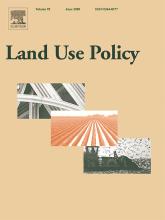Resource information
This study examined the trends, driving factors, and implications of land use/land cover (LULC) dynamics over the past 35 years (1982–2017) in three watersheds of the drought-prone areas that represent different agro-ecologies of Upper Blue Nile basin, Ethiopia: Guder (highland), Aba Gerima (midland), and Debatie (lowland). The changes in LULC were analyzed by integrating field observations, remote-sensing data (aerial photographs [1: 50,000 scale] and very high resolution [0.5–3.2 m] satellite images), and geographic information systems. The drivers of LULC were explored using key informant interviews and relevant literature reviews. The implications of LULC change on soil erosion and surface runoff responses were also evaluated. A minimum of four and maximum of six LULC classes were identified in each watershed over the study period. The study revealed that forest land was the dominant LULC class accounting for 40.9% and 32.0% in Guder and Aba Gerima, respectively in 1982. While in the same period, bush land (36.6%) was the dominant LULC class in Debatie watershed. From 1982 to 2016/2017, forest land, bush land, and grazing land respectively decreased by about 70%, 50%, and 27% in Guder; 65%, 49%, and 63% in Aba Gerima; and 63%, 59%, and 38% in Debatie. During the same period, cultivated land increased by approximately 40%, 129%, and 704% in Guder, Aba Gerima and Debatie, respectively. In contrast, between 2012 and 2017, plantation cover increased by about 400% in the Guder, mainly at the expense of cultivated land, which decreased by 40% for the same period. Population growth and associated changes in the farming practices were the major driving forces for the observed LULC changes in the study watersheds. The traditionally deleterious impacts of human activities on the environment have been recently reversed at an unprecedented rate, particularly at Guder and to a lesser extent at Aba Gerima, following the shift from the traditional annual cropping to more economically attractive tree-based farming practices such as Acacia decurrens plantation in Guder and khat (Catha edulis) cultivation in Aba Gerima. The continued expansion of cultivated land combined with population growth positively linked to the increase of gully erosion and surface runoff potential in the study watersheds particularly, in Aba Gerima and Debatie watersheds. The Upper Blue Nile basin is currently experiencing both positive and negative socio-economic and environmental consequences of LULC dynamics. Hence, the present study can help form a basis for the appropriate development of land management policies and strategies in this and other basins experiencing similar problems.


